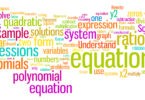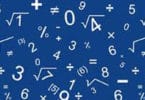Straight Line Questions (Mathematics):
A straight line through P(1, 2) is such that its intercept between the axes is bisected at P. Its equation is
(a) x + 2y = 5
(b) x – y + 1 = 0
(c) x + y – 3 = 0
(d) 2x + y – 4 = 0
The equations to a pair of opposite sides of a parallelogram are x2 – 5x + 6 = 0 and
y2 – 6y + 5 = 0. The equations to its diagonals are
(a) x + 4y = 13 and y = 4x – 7
(b) 4x + y = 13 and 4y = x – 7
(c) 4x + y = 13 and y = 4x – 7
(d) y – 4x = 13 and y + 4x = 7
If P = (1, 0), Q = (-1, 0), R = (2, 0) are 3 given points, then the locus of the point S satisfying the relation SQ2 + SR2 = 2SP2 is
(a) a straight line parallel to the x-axis
(b) circle through the origin
(c) circle with centre at theorigin
(d) a straight line parallel to the y-axis.
Related: biot savart law example problems
The points A(–4, –1), B(–2, –4), C(4, 0) and D(2, 3) are the vertices of a
(a) square
(b) rectangle
(c) rhombus
(d) none of these
The area enclosed by |x| + |y| = 1 is
(a) 1
(b) 2
(c) 3
(d) 4
If the lines ax + by + c = 0;, bx + cy + a = 0 and cx + ay + b = 0 be concurrent, then
(a) a3 + b3 + c3 + 3abc = 0
(b) a3 + b3 + c3 – abc = 0
(c) a3 + b3 + c3 – 3abc = 0
(d) None of these
If (–6, -4) and (3, 5) are the extremities of the diagonals of a parallelogram and (-2, 1) is its third vertex, then its fourth vertex is
(a) (-1, 0)
(b) (0, -1)
(c) (-1, 1)
(d) none of these
Related: Free Trigonometry Practice Tests
The straight line passing through the point of intersection of the straight lines x – 3y+1 = 0 and 2x +5y – 9 = 0 and having infinite slope and at a distance 2 units from the origin has the equation
(a) x = 2
(b) 3x + y – 1 = 0
(c) y = 1
(d) None of these
In the equation y – y1 = m(x – x1) if m and x1 are fixed and different lines are drawn for different values of y1, then
(a) The lines will pass through a single point
(b) There will be a set of parallel lines
(c) There will be one line only
(d) None of these
Which of the following lines is concurrent with the lines 3x + 4y + 6 = 0and 6x + 5y + 9 = 0
(a) 2x + 3y + 5 = 0
(b) 3x + 3y + 5 = 0
(c) 7x + 9y + 3 = 0
(d) None of these
If x1, x2, x3 as well as y1, y2, y3 are in G.P. with the same common ratio, then the points (x1, y1), (x2, y2) and (x3, y3)
(a) Lie on a straight line
(b) Lie on an ellipse
(c) Lie on a circle
(d) Are vertices of a triangle
The coordinates of the middle points of the sides of a triangle are (3, 2) (4, 3) and (2, 2). Then the coordinates of its centroid are
(a) (3, 7/3)
(b) (3, 3)
(c) (4, 3)
(d) none of these
Related: Chemistry Redox Reactions Questions
The points A(2a, 4a), B(2a, 6a), C(2a + Ö3 a, 5a), a > 0 are the vertices of
(a) a right angled triangle
(b) an equilateral triangle
(c) an isosceles triangle
(d) none of these
The value of k for which the lines 7x – 8y + 5 = 0, 3x – 4y + 5 = 0 and 4x + 5y + 5 = 0 are concurrent is given by
(a) – 45
(b) 44
(c) 54
(d) – 54
The medians AD and BE of a triangle ABC with vertices A(0, b) B(0, 0) and C(a, 0) are perpendicular to each other if
(a) b = Ö2a
(b) a = Ö2b
(c) b = –Ö2a
(d) none of these
Consider the equation y – y1 = m(x – x1). If m and x1 are fixed and different lines are drawn for different values of y1, then
(a) the line will pass through a fixed point
(b) there will be a set of parallel lines
(c) all the lines will be parallel to the line y = y1
(d) none of these
For what value of ‘a’ the lines x = 3, y = 4 and 4x – 3y + a = 0 are concurrent
(a) 0
(b) –1
(c) 2
(d) 3
Related: Hydraulics And Fluid Mechanics MCQ
The nearest point on the line 3x + 4y = 25 from the origin is
(a) (-4, 5)
(b) (3, -4)
(c) (3, 4)
(d) (3, 5)
The intercept of a line between the coordinate axes is divided by point (– 5, 4) in the ratio 1 : 2. The equation of the line will be
(a) 5x – 8y + 60 = 0
(b) 8x – 5y + 60 = 0
(c) 2x – 5y + 30 = 0
(d) None of these
The points (-a, -b), (0, 0), (a, b) and (a2, ab) are
(a) collinear
(b) vertices of a parallelogram
(c) vertices of a rectangle
(d) none of these
The lines 15x – 18y + 1 = 0, 12x + 10y – 3 = 0 and 6x + 66y – 11 = 0 are
(a) Parallel
(b) Perpendicular
(c) Concurrent
(d) None of these
A straight line moves so that the sum of the reciprocals of its intercepts on the co-ordinate axes is unity. Then
(a) the straight line always passes through fixed point (1, 1)
(b) it does not pass through any fixed point
(c) it passes through the origin
(d) none of these
Related: AP and GP Problems with answers
The point of intersection of the lines x/a + y/b = 1 and x/b + y/a = 1 lies on the line
(a) x – y = 0
(b) (x – y) (a + b) = 2ab
(c) (lx + my) (a – b) = (l + m)ab
(d) (lx – my) (a – b) = (1 – m)ab
The three lines 4x – 7y + 10 = 0, x + y = 5 and 7x + 4y = 15 form the sides of a triangle. Then the point (1, 2) is its
(a) centroid
(b) incentre
(c) orthocenter
(d) none of these
The straight lines x + 2y – 9 = 0, 3x + 5y – 5 = 0 and ax + by – 1 = 0 are concurrent, if the straight line 35x – 22y + 1 = 0 passes through the point
(a) (a, b)
(b) (b, a)
(c) (–a, –b)
(d) None of these
Points on the line x + y = 4 that lie at a unit distance from the line 4x + 3y – 10 = 0 are
(a) (3, 1) and (-7, 11)
(b) (-3, 7) and (2, 2)
(c) (-3, 7) and (-7, 11)
(d) none of these
In a rhombus ABCD, the diagonals AC and BD intersect at the point (1, 2). If the point B is (2, 3), the diagonal AC has equation
(a) x + y = 0
(b) x – y = 3
(c) x – y = 0
(d) x + y = 3
Related: Permutation and Combination MCQ
The solution of equations x + y = 10, 2x + y = 18 and 4x – 3y = 26 will be
(a) Only one solution
(b) No Solution
(c) Infinite solution
(d) None of these
The straight line passing through the point of intersection of the straight lines x – 3y + 1 = 0 and 2x + 5y – 9 = 0 and having infinite slope and at a distance of 2 units from the origin, has the equation
(a) x = 2
(b) 3x + y – 1 = 0
(c) y = 1
(d) None of these
The number of values of c such that the straight line y = 4x + c touches the curve x2/4 + y2 = 1 is
(a) 0
(b) 1
(c) 2
(d) Infinite
The equations of the lines through (-1, -1) and making angle 45° with the line x + y = 0 are given by
(a) x + 1 = 0, x – y = 0
(b) y + 1 = 0, x – y = 0
(c) x + 1 = 0, y + 1= 0
(d) none of these
Related: Sets, Relations and Functions questions
Let the vertices of a triangle be (0, 0), (3, 0) and (0, 4). Its orthocentre is
(a) (0, 0)
(b) (1, 4/3)
(c) (3/2, 2)
(d) none of these
For the straight lines given by the equation (2 + k)x + (1 + k)y = 5 + 7k, for different values of k which of the following statements is true
(a) Lines are parallel
(b) Lines pass through the point (– 2, 9)
(c) Lines pass through the point (2, – 9)
(d) None of these
If the pair of straight lines xy – x – y + 1 = 0 and the line ax + 2y – 3 = 0 are concurrent, then a =
(a) – 1
(b) 0
(c) 3
(d) 1






